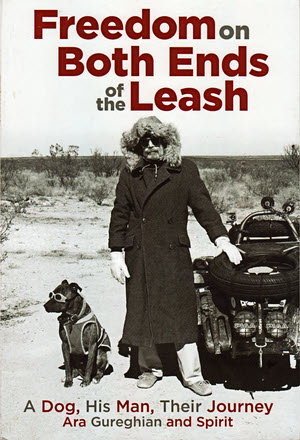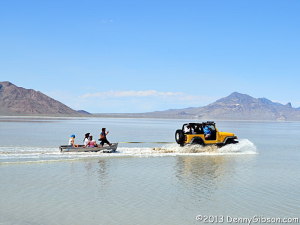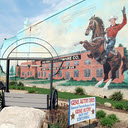 In The Soul of a New Machine, a true story about computer development in the 1970s where microseconds are a common measuring unit, one of the engineers explains his abrupt abandonment of the team with a note left on his computer terminal: “I’m going to a commune in Vermont and will deal with no unit of time shorter than a season.” I recently thought of that line as I read Freedom on Both Ends of the Leash and thought I’d use it in my review but did not. Ara and Spirit, the writers of Freedom…, essentially live on the road and adjust their travels to be in the cooler north during the summer and in the south for winters. On occasion they have to deal with calendars and even clocks but the only unit of time they deal with on a regular basis is the season. I sometimes like to think that I deal with no unit of time less than a season but it’s not true. I also sometimes like to think that I’d like to live where the temperature is a constant 75 degrees but that’s not true either. I’ve been watching the seasons change for too long to quit now.
In The Soul of a New Machine, a true story about computer development in the 1970s where microseconds are a common measuring unit, one of the engineers explains his abrupt abandonment of the team with a note left on his computer terminal: “I’m going to a commune in Vermont and will deal with no unit of time shorter than a season.” I recently thought of that line as I read Freedom on Both Ends of the Leash and thought I’d use it in my review but did not. Ara and Spirit, the writers of Freedom…, essentially live on the road and adjust their travels to be in the cooler north during the summer and in the south for winters. On occasion they have to deal with calendars and even clocks but the only unit of time they deal with on a regular basis is the season. I sometimes like to think that I deal with no unit of time less than a season but it’s not true. I also sometimes like to think that I’d like to live where the temperature is a constant 75 degrees but that’s not true either. I’ve been watching the seasons change for too long to quit now.
 Trees around here seem to be changing color later or maybe I’m just anxious. A burst of warm and sunny days can do that to you. A burst that promises to continue through Monday started on Thursday and I took advantage of it to do some country road cruising. It wasn’t just aimless driving, though. I headed to nearby Greene County and followed a covered bridge driving tour described in a brochure I picked up some time ago.
Trees around here seem to be changing color later or maybe I’m just anxious. A burst of warm and sunny days can do that to you. A burst that promises to continue through Monday started on Thursday and I took advantage of it to do some country road cruising. It wasn’t just aimless driving, though. I headed to nearby Greene County and followed a covered bridge driving tour described in a brochure I picked up some time ago.
The five covered bridges in the county, pictured in the order I visited them, are the 1887 Engle Mill Road Bridge, the 1883 Ballard Road Bridge, the 2013 Charleton Mill Road Bridge, the 1877 Stevenson Road Bridge, and the 1886 Grinnel Road Bridge. The brochure describes an 1883 bridge at the Charleton Mill Road location but that was closed, for safety reasons, in 2011 and what looks to be an exact duplicate opened there in 2013.


 None of the bridges were surrounded by the glorious fall foliage I had hoped for and I never did find one of those walls of intermixed red, orange, and yellow that trigger oohhs and aahhs like some fireworks display, but I did find some nice touches of color around several farm houses.
None of the bridges were surrounded by the glorious fall foliage I had hoped for and I never did find one of those walls of intermixed red, orange, and yellow that trigger oohhs and aahhs like some fireworks display, but I did find some nice touches of color around several farm houses.
 I did some more country road cruising on Friday and this time it was pretty aimless. Still no big walls of bold color, though. No biggie. At the end of the day, I was more than satisfied with the warm temperatures, blue skies, and the occasional splash of orange. I think the guys in the boat were, too.
I did some more country road cruising on Friday and this time it was pretty aimless. Still no big walls of bold color, though. No biggie. At the end of the day, I was more than satisfied with the warm temperatures, blue skies, and the occasional splash of orange. I think the guys in the boat were, too.
On Saturday I helped friends celebrate a wedding anniversary. I was best man at their wedding and have joined John and Sherry for some sort of merrymaking on most anniversaries. Over the years, both the level of partying and the degree of scheduling precision have lessened. This year it took us nearly three months to work through scheduling conflicts but we did eventually make the distillery visit that was originally planned for July.


 Indian Creek Distillery near New Carlisle, Ohio, is home to the oldest operating stills in the United States. In 2011, Joe and Missy Duer brought back to life the nearly 200 year old copper stills that Missy’s ancestors used to produce Staley Rye Whiskey in the early nineteenth century. The stills and other equipment had been hidden when Prohibition hit. Now they are installed in an old looking new building and making rye whiskey the old fashioned way from the original Elias Staley recipe.
Indian Creek Distillery near New Carlisle, Ohio, is home to the oldest operating stills in the United States. In 2011, Joe and Missy Duer brought back to life the nearly 200 year old copper stills that Missy’s ancestors used to produce Staley Rye Whiskey in the early nineteenth century. The stills and other equipment had been hidden when Prohibition hit. Now they are installed in an old looking new building and making rye whiskey the old fashioned way from the original Elias Staley recipe.






 I really looked forward to the publication of this book. I certainly enjoyed reading it and expect to enjoy reviewing it once I get started but reviewing a book that is near impossible to describe isn’t all that easy. Saying it is the story of a man and dog traveling around the US on a motorcycle isn’t wrong but it sure is incomplete. The man, Ara Gureghian, and the dog, Spirit, have been traveling around the US on a motorcycle since November of 2006 with no plans to stop. I’ve followed their blog since April, 2007, and I have no plans to stop, either. When they started their journey, they were not leaving a home where they planned to someday return. They did acquire some land fairly early on and they do spend winters there but even it is more of a base camp than what most would call a home. From the beginning, Ara had called his online journal The Oasis of My Soul and the ten acres of Texas that his mother bought for him instantly became known as The Oasis. One definition of oasis is “something that provides refuge, relief, or pleasant contrast” and that is something both man and dog needed. Ara had suffered the painful loss of his son and Spirit has suffered abuse from a previous owner. Almost everything — the riding, the writing, the sunrises, the stars, the sunsets — is therapy to some degree but the writing is particularly therapeutic. Ara wrote, and continues to write, his journal for himself. He writes about his travels, his surroundings, and his thoughts. This book is something of a “Reader’s Digest” version of the journal. Neither book nor journal actually tries to be a travel guide or provide insights into living. Nonetheless, they do both.
I really looked forward to the publication of this book. I certainly enjoyed reading it and expect to enjoy reviewing it once I get started but reviewing a book that is near impossible to describe isn’t all that easy. Saying it is the story of a man and dog traveling around the US on a motorcycle isn’t wrong but it sure is incomplete. The man, Ara Gureghian, and the dog, Spirit, have been traveling around the US on a motorcycle since November of 2006 with no plans to stop. I’ve followed their blog since April, 2007, and I have no plans to stop, either. When they started their journey, they were not leaving a home where they planned to someday return. They did acquire some land fairly early on and they do spend winters there but even it is more of a base camp than what most would call a home. From the beginning, Ara had called his online journal The Oasis of My Soul and the ten acres of Texas that his mother bought for him instantly became known as The Oasis. One definition of oasis is “something that provides refuge, relief, or pleasant contrast” and that is something both man and dog needed. Ara had suffered the painful loss of his son and Spirit has suffered abuse from a previous owner. Almost everything — the riding, the writing, the sunrises, the stars, the sunsets — is therapy to some degree but the writing is particularly therapeutic. Ara wrote, and continues to write, his journal for himself. He writes about his travels, his surroundings, and his thoughts. This book is something of a “Reader’s Digest” version of the journal. Neither book nor journal actually tries to be a travel guide or provide insights into living. Nonetheless, they do both.

 This week I lost something I’d had for forty years. In 1974 I contacted United Telephone of Ohio to arrange for a phone in my first post-divorce home. It was a rental unit in a trailer park near Morrow, Ohio. Few things say noncommittal like renting a mobile home. Unlike the big outfits such as Cincinnati Bell, United couldn’t assign me a number when I placed the order. “We’ll have to see what works,” I was told. What worked was (513) 683-4125. I carried the number through another United Telephone served address plus three different addresses in Cincinnati Bell territory. On Thursday, the land line associated with it was switched off and, for the first time in four decades, (513) 683-4152 became available for reassignment. Here’s how it happened.
This week I lost something I’d had for forty years. In 1974 I contacted United Telephone of Ohio to arrange for a phone in my first post-divorce home. It was a rental unit in a trailer park near Morrow, Ohio. Few things say noncommittal like renting a mobile home. Unlike the big outfits such as Cincinnati Bell, United couldn’t assign me a number when I placed the order. “We’ll have to see what works,” I was told. What worked was (513) 683-4125. I carried the number through another United Telephone served address plus three different addresses in Cincinnati Bell territory. On Thursday, the land line associated with it was switched off and, for the first time in four decades, (513) 683-4152 became available for reassignment. Here’s how it happened. Amtrak has a simple but incredibly effective way of avoiding scenes like this at its station in Cincinnati. Eastbound trains are scheduled to depart at 3:27 AM; Westbound at 1:23 AM. That’s AM as in “ante meridian”, as in “before midday”, as in “middle of the night”, as in “dark as a black cat in a coal mine”. That would seem to be sufficient discouragement, but just to be on the safe side, Amtrak frequently misses those times by sizable amounts. On rare occasions, they might even cancel a train a day or two before departure, as they did for me in
Amtrak has a simple but incredibly effective way of avoiding scenes like this at its station in Cincinnati. Eastbound trains are scheduled to depart at 3:27 AM; Westbound at 1:23 AM. That’s AM as in “ante meridian”, as in “before midday”, as in “middle of the night”, as in “dark as a black cat in a coal mine”. That would seem to be sufficient discouragement, but just to be on the safe side, Amtrak frequently misses those times by sizable amounts. On rare occasions, they might even cancel a train a day or two before departure, as they did for me in